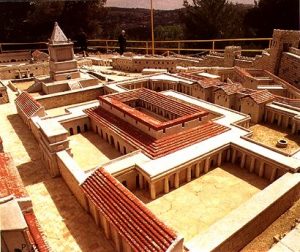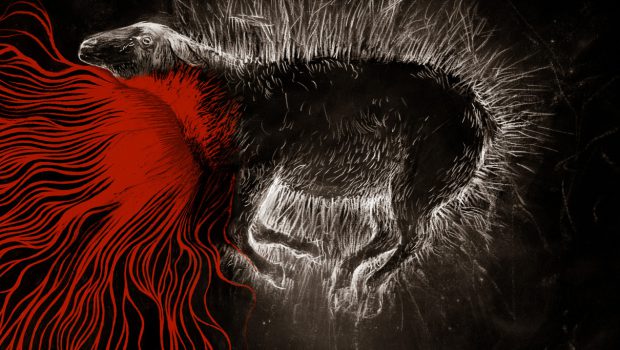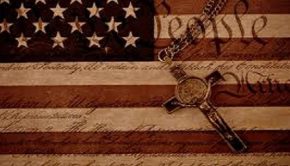Holy Week: Good Friday
Midnight – 5 AM
Jesus was arrested Thursday night under the cover and secrecy of darkness. Because of the shadows, Judas, his betrayer, had to identify him to the nearly 600 men that came into the garden expecting a fight. Judas chose to mark Jesus for death with a greeting. A kiss. This was the usual way a disciple would greet his rabbi. Imagine, in our culture, a handshake. Or an embrace. As the crowd from the chief priests stepped forward toward Jesus, the rest of the disciples except for Peter, confused and afraid, ran away. He tried to fight. After Jesus rebuked him, he ran away with the rest.
Jesus was, then, taken to the house of Annas, the previous high priest, and father-in-law to the current high priest (John 18:13). Annas was put in place by the Romans and considered High Priest for life and so had authority to question Jesus. Caiaphas, the current high priest, may have sent Jesus to his father-in-law to confirm his suspicions or to buy time to make sure the next trial was staged perfectly. Jesus’ trial before Annas was more of an interrogation with Jesus remaining silent. Afterward, he was moved to his official trial before the Sanhedrin.

Historical rendering of Caiaphas’ palace, where Jesus’ second trial was held and where Peter denied him.
This trial was rigged from the start. As you may recall, the Sadducees attempted to get Jesus to incriminate himself in the days preceding. This was their last resort. They knew they wanted to arrest him and have him killed, so they had to have a trial, but this was a farce and nothing more than pretense. Jewish trials never took place at night. It’s clear that not all members of the Sanhedrin are present, namely potentially dissenting Pharisees (John 3:1-2; Luke 23:50-51), meaning this trial would be decided almost exclusively by Sadducees. At the trial, multiple witnesses were called forward offering testimony against Jesus, but they all contradicted one another. This clearly demonstrates that the Sanhedrin had already decided Jesus’ fate prior and this was no “trial” at all. The only thing the witnesses had in common was a claim Jesus made about destroying the Temple and rebuilding it in 3 days (John 2:19). However, when Jesus was asked about this, he remained silent (Isaiah 53:7). Many other direct questions were asked of Jesus and, still, he didn’t answer. It wasn’t until he was put under oath (Matt. 26:62) for the most important question of the evening that he answered. When asked if he was the Messiah, Jesus did not deny it. Caiaphas responds as the high priest is directed to when they hear blasphemy. He tore his shirt, not out of rage, but to indicate Jesus’ guilt. This was the perfect situation for the Sanhedrin. Though their trial was a sham and their witnesses had failed, Jesus had implicated himself. He had called himself God. What they failed to consider, however, was that Jesus might be telling the truth.
Convicted of blasphemy, Jesus was condemned to die and at the most unfortunate time Peter, who was outside listening and watching, was recognized as one of Jesus’ disciples. While Peter’s denial is stark in comparison with his promise to never betray Christ (Matt. 26:35), understand his situation. Suppose you were outside the room where your friend had just been convicted and sentenced to die in an obviously unjust manner and someone starts a commotion about how you were one of his close friends. It’s easy to sit and say, “I never would have denied Christ,” but could it be because you know how the story ends? In that moment, Peter and the rest of the disciples felt their worlds unraveling, and we would do well understand that is how it felt.
5 AM – 9 AM
It’s unclear how long Jesus’ trial before the Sanhedrin took. It could have taken as many as 5 hours. It could also have been as few as 2. What we do know is that Jesus was taken before the Roman Governor, Pilate, first thing Friday morning, probably around dawn. If Jesus’ trial was shorter, the Sanhedrin would have kept him in a prison before taking him to see Pilate. Since the Gospel writers don’t mention this, it’s assumed that the trial lasted all night into the morning and after the verdict was handed down, they immediately took Jesus to see Pilate.

Historical rendering of Herod’s Praetorium. Possibly where Jesus was presented to Pilate and met with Herod.
After convicting Jesus of blasphemy, the council wanted to kill him, but because of the Roman occupation, they didn’t have the authority to carry out the capital punishment laws laid out in the Torah (John 18:31). As a result, they had to sell a blasphemy charge, a religiously Jewish crime, to a Roman pagan. So when they approached Pilate, they spun the story in such a way to make Jesus look like a revolutionary. An insurrectionist. A Zealot. “We found this man misleading our nation and forbidding us to give tribute to Caesar, and saying that he himself is Christ, a king,” (Luke 23:1-2). Pilate wanted to be sure, so he asked Jesus some preliminary questions. He remained unconvinced. Upon discovery that Jesus was a Galilean, he sent him to Herod Antipas, the Jewish ruler placed over Galilee by the Romans.
Like all Jews, Herod was in Jerusalem for the Passover festival rather than in Galilee, though he was Hellenized through and through. When Jesus arrived, Herod was excited to meet him, not so he could question him, but so he could see a miracle or magic trick. He cared little about the charges being brought. Instead, he mocked him and sent him back to Pilate. After Jesus’ return, Pilate called the chief priests together and said, “I’ve questioned, convicted, and killed a lot of insurrectionists. Jesus isn’t one of them. Not to mention Herod, the overseer of ‘Zealot country’ doesn’t seem to think he is one either. He doesn’t deserve to die, but since you think he’s guilty of something, I will punish him and then release him,” (Lk. 23:13-16). But the crowds wanted Jesus dead.

CLICK TO ENLARGE: The path from Jesus’ arrest to his crucifixion is difficult to retrace with certainty. According to a possible harmony of the Gospel accounts, after the Passover meal, Judas led a contingent of soldiers to Gethsemane to arrest Jesus (1). From there Jesus was led to Annas (location unknown), who sent him to his son-in-law Caiaphas, the high priest (2). The Jewish leaders then appealed to the Roman governor Pilate to have Jesus put to death (3). Luke records that Pilate sent Jesus to Herod Antipas (4), who questioned Jesus but returned him to Pilate without rendering any judgment (5). Pilate then sent Jesus to be crucified at Golgotha (6). (ESV Study Bible)
There is a commonly held belief that these crowds were the same crowds present at Jesus’ entry into Jerusalem. Though it’s commonly held, it’s largely unsubstantiated. Given that it’s probably around 7 or 8 am (John 18:28), there weren’t large crowds gathered, but rather influential crowds, which is what causes Pilate to cave. There is also nothing in the text to suggest that these crowds are composed of the same people. What the Sunday crowd and the Friday crowd demonstrate, however, is how deeply divided Jerusalem was over Jesus and, unfortunately, the pro-Jesus constituency was out maneuvered by the anti-Jesus constituency while they were literally sleeping.
At that time of the year, it was tradition for a prisoner to be released, so Pilate, attempting to set Jesus free, brought out a known criminal and Zealot, who was actually guilty of the type of insurrection of which Jesus was accused of along with murder of a Hellenized Sadduceean priest (which was a common practice among the Zealots at that time). Pilate felt he had out smarted the Sadducees. Why would they release a known rebel who kills priests for a man he was convinced didn’t have any Zealot leanings at all? And so he asked, “Should I release Barabbas or Jesus called the Christ?”
Interestingly, some ancient manuscripts of Matthew 27:16–17 have the full name of Barabbas as “Jesus Barabbas” and this was probably the name as originally written in the text, (Craig A. Evans. Matthew (New Cambridge Bible Commentary) p. 453). Many textual scholars believe the double name “Jesus Barabbas” was the original reading. They suggest that “Jesus” was omitted from several Greek manuscripts of Matthew out of reverence, (Bruce M. Metzger, ed. A Textual Commentary on the Greek New Testament. 2d ed. p. 56). The variant “Jesus Barabbas” in Matthew 27:16-17 occurs in only a few Greek and Syriac manuscripts. It is absent in the major 4th and 5th-century uncials, however, the variant was chosen by the translators of the CEV (in text), HCSB (in margin), ISV (in text), NRSV (in text), and RSV (in text) among many others. Supposing this is correct, not only do these two men have the same name, ‘Jesus,’ but the name “bar Abbas” means “son of (bar) the Father (Abbas).” Do you see the irony? The Sadducees have before them two Jesus-es. Both claim to be the son of the Father. And they choose to set the wrong one free.
Pilate realizes he cannot control the crowds and fears that a riot will break out, so he “washes his hands” of the matter and turns Jesus over to be killed.
Jesus was then scourged or flogged (which comes from the Latin word flaggelum meaning “whip”). Jesus was beaten with a leather whip possibly woven with bits of bone or shards of pottery. It’s also possible that the leather of the whip was knotted in such a way as to inflict maximum pain. It was common practice for Romans to flog men who were about to be crucified. Jewish Law prohibited more than 40 lashes, but since the Romans were in charge in this instance, it’s not clear how many or how few whips Jesus endured. Considering it was the Romans, who were masters of execution, this beating was undoubtedly severe. Afterward, the Romans began mock Jesus by making him a crown of thorns, probably from a local bush or shrub called the Jerusalem Thorn, and then beating it onto his head.
Consider for a moment the trauma Jesus’ body has gone through up to this point. His last meal (and possibly drink) was the previous night. He has probably gotten little to no sleep. He has been beaten with hands at least 3 times. He has been flogged and had thorns beaten into his scalp.
9 AM – 3 PM
 Jesus was then made to carry his cross outside the city to be crucified. This was common practice, but our perception can be skewed. Those being crucified were not made to carry the entire cross, but simply the crossbar. The vertical beam would have been left in the ground at the crucifixion site as a warning much like the hangman’s gallows being left in the public square. However, this doesn’t negate the weight (approx. 100+ lbs) across Jesus’ bare back. It actually became too much for him and he had to have help making it to the crucifixion site (Luke 23:26). These crosses would also have been reused. Wood was difficult to come by in that part of the world, so the frugal Romans would have reused the crosses over and over again. This means that Jesus’ cross was not pristine, sanded, or pretty, but quite possibly stained with other men’s blood, sweat, urine, feces, or vomit among other things.
Jesus was then made to carry his cross outside the city to be crucified. This was common practice, but our perception can be skewed. Those being crucified were not made to carry the entire cross, but simply the crossbar. The vertical beam would have been left in the ground at the crucifixion site as a warning much like the hangman’s gallows being left in the public square. However, this doesn’t negate the weight (approx. 100+ lbs) across Jesus’ bare back. It actually became too much for him and he had to have help making it to the crucifixion site (Luke 23:26). These crosses would also have been reused. Wood was difficult to come by in that part of the world, so the frugal Romans would have reused the crosses over and over again. This means that Jesus’ cross was not pristine, sanded, or pretty, but quite possibly stained with other men’s blood, sweat, urine, feces, or vomit among other things.

This is the side of a hill outside of Jerusalem and may be the hill where crucifixions were held. This unique rock formation may have led to the name “Place of the Skull.”
They led him to a hill called Golgotha in Aramaic, Calvary in Latin, Cranium in Greek, or Place of the Skull in English. It’s unclear if it’s because this was where people were killed or because of a unique rock formation on the side of the mountain or both. Crucifixion was intentionally done publicly, generally by a busy thoroughfare, so that those who saw it would know that Rome didn’t tolerate dissension. To make it clear what each man was guilty of, the charges were nailed above them so that passersby would know what type of behavior Rome did not permit.
“And they crucified him.”
Crucifixion was invented by the Persians in 500 B.C. It was perfected by the Romans during the time of Jesus and was continued until outlawed by Constantine in the 300’s. It was quite literally the most horrible way to die. It was so horrible in fact that Romans would not crucify their own citizens. It was reserved for the worst non-Romans offenders. The most horrible Roman offenders were simply beheaded. It was so horrible that the Jews considered anyone hung on a tree in that way cursed by God (Deut. 21:23). It was so horrible that the Greeks said that no decent person should even discuss it. During its history in the Roman Empire, thousands upon thousands upon thousands of people were crucified. After Spartacus’ rebellion, 6,000 of his followers were crucified in one day lining the road for 120 miles. Men were hung on the cross naked to add to their shame and kept there by driving 7 – 9 inch nails in their hands and feet. The vertical and horizontal beams were attached, probably with rope, and the entire apparatus was dropped into a hole to keep it upright. The person on the cross would have been no more than 2 feet off the ground making them virtually eye level with the crowds, who often showed up drunk hurling rocks and insults at those on the cross.
Death by crucifixion was death by suffocation. Because of the way the body hung, the diaphragm couldn’t expand. In order to get just one breath, the victim would have to push themselves upward putting all the stress on the nails in their feet. Once that became unbearable, they would slide back down putting all the stress back on the nails in their hands. This is what they had to do to for every breath and it’s clear why the Romans whipped their backs prior to crucifixion. Crucifixion was intentionally slow and the person on the cross would pass in and out of consciousness as they hung for days suffering from heat exhaustion and dehydration during the day and potential hypothermia at night. To expedite the process, the Romans would break the legs of the person on the cross so they could no longer push upward to breathe, suffocating them.

Artist rendering of the tomb of Joseph of Arimathea
Jesus was nailed to the cross around 9 A.M. and hung there until about 3 P.M. with strange darkness coming at noon and remaining until about 3 P.M. when Jesus died. It’s unclear how long Jesus was on the cross after he died, but due to Jewish Sabbath laws, the bodies had to be taken down before sunset. This led the Romans to expedite the death of the two criminals, likely insurrectionist Zealots, beside Jesus by breaking their legs. However, when they came to Jesus, they saw that he was already dead which was strange given how long it usually took to die on a cross. To ensure that he was dead, they thrust a spear into his rib cage causing blood and water to flow from his side. Now convinced he was dead, these professional executioners took Jesus’ body down from the cross and turned it over to his friend, Joseph of Arimathea, who requested that he place Jesus in his family burial chamber newly hewn out of the rock.
It was there that the lifeless body of Jesus the Christ lay. Let us not skip too lively or obliviously to Resurrection Sunday forgetting that Jesus actually died. He was really dead.
It has been said that Good Friday only matters because there’s a Resurrection Sunday, and I believe this is true. But, on the other hand, there is a Resurrection Sunday only because of Good Friday, because Christ was actually dead. So, as Good Friday comes to a close and we approach Holy Saturday and contemplate Christ’s brutal, selfless sacrifice, all we can do is wait.











